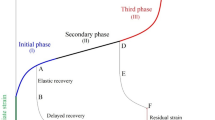Abstract
Existing analytical methods of buried steel pipelines subjected to active strike-slip faults depended on a number of simplifications. To study the failure mechanism more accurately, a refined strain analytical methodology was proposed, taking the nonlinear characteristics of soil-pipeline interaction and pipe steel into account. Based on the elastic-beam and beam-on-elastic-foundation theories, the position of pipe potential destruction and the strain and deformation distributions along the pipeline were derived. Compared with existing analytical methods and three-dimensional nonlinear finite element analysis, the maximum axial total strains of pipe from the analytical methodology presented are in good agreement with the finite element results at small and intermediate fault movements and become gradually more conservative at large fault displacements. The position of pipe potential failure and the deformation distribution along the pipeline are fairly consistent with the finite element results.
Similar content being viewed by others
References
GU Xiao-ting, ZHANG Hong. Research on aseismatic measures of gas pipeline crossing a fault for strain-based design [C]// Pressure Vessels and Piping Conference 2009. Prague, Czech Republic: American Society of Mechanical Engineers, 2010: 571–580.
JIAO Zhong-liang, SHUAI Jian, HAN Ke-jiang. Response analysis of buried pipeline subjected to fault movements [C]// International Conference on Pipelines and Trenchless Technology 2009: Advances and Experiences with Pipelines and Trenchless Technology for Water, Sewer, Gas, and Oil Applications. Shanghai, China: American Society of Civil Engineers, 2009: 1212–1218.
LIU Ming, WANG Yong-yi, YU Zhi-feng. Response of pipelines under fault crossing [C]// Proceedings of the International Offshore and Polar Engineering Conference. Vancouver, BC, Canada: International Society of Offshore and Polar Engineers, 2008: 162–165.
ZHU Qing-jie, CHEN Yan-hua, LIU Ting-quan, DAI Zhao-li. Finite element analysis of fluid-structure interaction in buried liquid-conveying pipeline [J]. Journal of Central South University of Technology, 2008, 15(Suppl. 1): 307–310.
NEWMARK N M, HALL W J. Pipeline design to resist large fault displacement [C]// Proceedings of US Conference on Earthquake Engineering. Ann Arbor, Michigan: Earthquake Engineering Research Institute, 1975: 416–425.
KENNEDY R P, CHOW A W, WILLIAMSON R A. Fault movement effects on buried oil pipeline [J]. Transportation Engineering Journal, 1977: 617–633.
WANG L R L, YEH Y H. A refined seismic analysis and design of buried pipeline for fault movement [J]. Earthquake Engineering and Structural Dynamics, 1985, 13: 75–96.
KARAMITROS D K, BOUCKOVALAS G D, KOURETZIS G P. Stress analysis of buried steel pipelines at strike-slip fault crossings [J]. Soil Dynamics and Earthquake Engineering, 2006, 27: 200–211.
HA D, ABDOUN T H, O’ROURKE M J. Soil-pipeline interaction behavior under strike-slip faulting [C]// Proceedings of the Geotechnical Earthquake Engineering and Soil Dynamics IV Congress 2008. Sacramento, CA, United States: American Society of Civil Engineers, 2008: 1–10.
WIJEWICKREME D, KARIMIAN H, HONEGGER D. Response of buried steel pipelines subjected to relative axial soil movement [J]. Canadian Geotechnical Journal, 2009, 46(7): 735–752.
COCCHETTI G, DI P C, GALLI A, NOVA R. Soil-pipeline interaction along unstable slopes: A coupled three-dimensional approach: Part 1. Theoretical formulation [J]. Canadian Geotechnical Journal, 2009, 46(11): 1289–1304.
FREDJ A, DINOVITZER A, ZHOU J. A 3-dimentional continuum ale model for soil-pipe interaction [C]// Proceedings of the ASME International Pipeline Conference-2008. Calgary, Canada: American Society of Mechanical Engineers, 2009: 905–915.
American Lifeline Alliance. Guidelines for the design of buried steel pipe [S]. America: American Society of Civil Engineers, 2001: 68–76.
ADINA theory and modeling guide. Volume I: ADINA [M]. Watertown, USA: ADINA R&D, Inc, 2004: 147–165.
SURESH R D, SUDHIR K J. IITK-GSDMA-EQ33-V2.0, Guidelines for seismic design of buried pipeline [S]. Kanpur, India: Authority Gujarat State Disaster Management, 2002: 26–27.
PetroChina Pipeline Company, Ocean University of China. SY/T 0450-2004, Code for seismic design of oil and gas steel pipeline [S]. Beijing: National Development and Reform Commission, 2004: 27–29. (in Chinese)
Author information
Authors and Affiliations
Corresponding author
Additional information
Foundation item: Project(50439010) supported by the National Natural Science Foundation of China; Project(DUT10ZD201) supported by the Fundamental Research Funds for the Central Universities in China
Rights and permissions
About this article
Cite this article
Wang, B., Li, X. & Zhou, J. Strain analysis of buried steel pipelines across strike-slip faults. J. Cent. South Univ. Technol. 18, 1654–1661 (2011). https://doi.org/10.1007/s11771-011-0885-1
Received:
Accepted:
Published:
Issue Date:
DOI: https://doi.org/10.1007/s11771-011-0885-1




